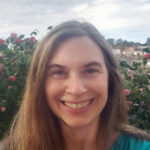From Rabbi Morris Allen:

In a Haggadah text filled with awe and wonder, perhaps the most significant comment Marcia Falk adds to the traditional Haggadah is this:By far the most important symbol at the table is the community of participants. “Whether two people or thirty are in attendance, tonight we represent am yisra’el, the people of Israel”. By placing the participants directly in with the other symbolic representations of the Seder, Falk underscores the centrality of Pesach as THE master narrative of the Jewish people. It is through this understanding that Falk reminds us of our particular heritage and responsibility, even as she celebrates aspects of universal concern and focus.
As our guests opened up this new Haggadah, one comment immediately stood out at our table. In reflecting on the color coding of the pages, a guest suggested that in doing so “she softened the telling immediately and enabled doubters to see a way in.” On her apricot pages are her brachot, blessings. Here we are to see a reimagined Divine which is the greater whole of which we are an inseparable part. Her metaphors are a wellspring of life, removing imagery of a Sovereign or a Lord. It is on those light blueberry/purple pages though—what she labels kavanot—that her poetic lens and insight might be most evident. For our guests, all of whom were obviously new to this Haggadah, two kavanot stood out and engendered the greatest discussion. The first was the pairing of the words of Emma Lazurus with those of Martin Luther King. Given the state of our country and of the world, the timelessness of those words paired together touched people in a unique fashion. The other was her kavanah immediately after Dayeinu. After a hearty singing of “it would have been enough”, we were introduced to the fact that “we begin as nothing, and we end as nothing. And in between——everything and nothing…joy and sorrow, beauty and decay…to give birth to and to let go.” Dayeinu and the gratitude it wants to create was understood—-perhaps for the first time—by everyone assembled.
As might be expected in any new Haggadah that seeks to engage in transformation and adaptation, pieces that might be familiar to Seder participants will be missing. In a world where anti-Jewish sentiment is still evident and increasing, her decision to remove both Vehee Sheamdah and Shfoch Hamatcha, didn’t sit well with some of our guests— not because each understood the animus directed towards us in the same way, but that, as a result, a central message was missing concerning what it has meant to be a minority inside this world. The other major absence was the famous dictum of Rabban Gamliel—“that whoever does not reflect on the significance of Pesach, Matzah and Maror, has not fulfilled their obligation”. While Falk is clear about her desire to stay away from traditional rabbinic commentary in her Haggadah-and thus would have been hard pressed to include this passage,its absence was noted. However, I found it quite easy to include each of these three short traditional pieces in her beautiful Maggid section.. I believe this Haggadah would have been well served hadFalk included this element in her bold commentary during the Maggid section. Perhaps it was part of her revealing and concealing—but its absence was jarring. For those who are accustomed to finishing the Seder after the meal, her rendering was filled with song in a way that the opening sections were not. Since she had already decided to re-order some aspects of the traditional text, perhaps an opportunity to add songs or sing a piece of the traditional Hallel before dinner might have been advised.
All concerns aside, Marcia Falk has contributed a great deal to the understanding of Pesach and the role it has to play in the life of every serious Jew. The exquisite poetry and the beautiful drawings force a way for even the most obdurate participant into an evening that is central to our people’s unfolding narrative. I felt blessed to have been able to share this text with our table guests and will look forward to using it again as one of the Haggadot which provides content for our Seder guests.
Rabbi Morris Allen is Rabbi Emeritus of Beth Jacob Congregation in Mendota Heights, MN and recently retired as the Senior Community Liaison for Rep. Angie Craig(MN-02)
From Ben Schein

We often talk about the Seder as being about “the order”. However, this year I have found myself thinking about ordering as a verb, as in we are going to order or really “re-order” the Seder itself. That is the core of what I found myself doing and appreciating in using Marcia Falk’s new Night of Beginnings: A Passover Haggadah. Falk’s “reorderings” stimulated my thinking. I really appreciated how she has created new sections of the Haggadah while still using the traditional order as its core. In the maggid, telling, she helps us understand that we introduce the story, then tell it in a way that preserves the integrity of the Biblical story itself. Throughout the Haggadah her color coding helps us be aware of the distinctiveness of each part of this liturgical coat of many colors.
Falk has also “re-ordered” by re-introducing old-new characters into the maggid itself. Moses and Miriam are no longer missing from the story. They are an integral part of the new seder of a Biblical maggid that was displaced over time. This is an act of creative recovery.
Lastly, we ”re-order” even how we bless. There is a very thoughtful new approach to blessings however that “re-orders” in the very radical sense of beginning the blessing formula with the human urge to bless rather than God being deserving of blessing. This was more than I could meaningfully assimilate. Lastly, we ”re-order” even how we bless. This was more than I could meaningfully assimilate. At some point, it felt disconnected from my understanding of the traditional order that works for me. It also felt like a generational disruption of l’dvor vador and I ended up creating a supplement with the traditional blessings. But that was my own choice in how to “re-order”. I hope Falk would appreciate that as part of the freedom we reappropriate each Pesach.
Ben Schein serves as Vice President of Data Curiosity at software company Domo, Inc. and lives in Saint Louis Park, Minnesota with his wife Robyn and children Ilan, Talia and Aryeh.
Rabbi Margie Jacobs:

Marcia Falk’s Night of Beginnings offers a wonderful balm to the overwhelm, anxiety, and harshness- the kotzer ruach and avodah kashah– of these times. This is a Haggadah that speaks intimately and gently to our hearts. The subtle flower sketches that permeate the pages gently invite us to unfold as a flower does. The spacious, soft visual beauty of this Haggadah calls to the places in us that words can’t reach, captured in Falk’s interpretation of the “The Child Who Cannot Ask.” Her generous, positive reconstruction of all four children was a favorite moment of the Seder for my family. Even in words, Falk manages to touch that which is hidden within us. The poetry of the expanded Song of Songs section and Marcia’s own poetic liturgy elicit the love and yearning within us that might catalyze our own liberation.The simplicity and spaciousness of the Haggadah left me wanting more words in just a few places, including a clear reconstruction of the four divine actions traditionally associated with each cup of wine.
The most profound absence noted at our Seder table was that of the traditional blessing construction. I am so grateful for the new ways of blessing that Marcia Falk has brought us, both here and in her groundbreaking Book of Blessings. Yet while most of my extended family found the poetic liturgy inviting and meaningful, I was surprised that even some of the Renewal-leaning, Berkeley guests missed the option of the traditional blessings. It might have been useful to bold or enlarge the “N’varech/ N’kadesh” language that was included on each blessing page, and provide a little more framing of the choice not to include the traditional construction in the introduction to the Haggadah.
Like Falk’s Book of Blessings, Night of Beginnings is a beautiful, creative, and much-needed resource. I imagine that over the years, our family will fill some of the empty spaces with ancient and new voices- in pencil so that they can evolve over time.
Rabbi Margie Jacobs is a Reconstructionist Rabbi, Jewish Studio Process Facilitator, and Website Designer for the Kaplan Center.
Rabbi Jeffrey Schein:

All the virtues of the Haggadah noted in reviews in popular journals–the beautiful prose-poetry, the delicate aesthetic illustrations, the invitation to move the Pesach journey along the axes of outward to inward, concealed to revealed–were at play during our Seder. Perhaps the supreme compliment came from a non-Jewish guest. Though explicitly non-religious, he wanted to bring a copy back to his fiancee in Singapore because of the spiritual values permeating the volume.
I facilitated the Maggid portion of the Seder. I was eager to help participants explore the deep feminism of Marcia Falk’s orientation and also to locate the volume in the tradition of new, contemporary Haggadot that dates back to the publication of The New Haggadah by Behrman House in 1941. Here is how I hoped the two intentions would come to fruition.
I began by suggesting that the 1941 Haggadah sought to open up the meaning of freedom and slavery. The refrain of that Haggadah is a litany of moments to see the theme of meavdut lecherut ,from slavery to freedom ,in the contemporary situation of the Jewish people in 1941. Hence slavery is encountered when we are enslaved to our emotions, when poverty and inequality are perpetuated for some, and when one slavishly sacrifices ones Jewish pride and connection to the altar of belonging to America. This was a bold “problematizing” of the notions of freedom and slavery that we take for granted.
Tellingly and unsurprisingly given its 1941 context there was no mention here of the slavery/ mitzrayim ,narrowness, of constricted gender roles and subjugation of females to males. But today we understand this. I found the most meaningful new addition to the Haggadah to be Marcia Falk’s expansion of avadim hayinu/atah be nai chorim ,once we were slaves now we are free, to include shifachot hayinu ata benot chorin ,once we were handmaidens now we are free women.
With more time we undoubtedly would have compared the status of Hebrew handmaids to the portraits we now encounter in works like The Help and The Handmaid’s Tale. Naming this form of gender based marginalization and reconstructing a song based on it, allowed me to see Marcia Falk in the line of creative Pesach liturgists begun with The New Haggadah (1941) and continuing today. At its best and boldest such reimaginings not only add new aesthetic dimensions but help us reconstruct our understanding of Judaism based on new ethical and spiritual considerations.
But I have no desire to downplay the role of ritual at all. We concluded the section by singing the shifachot hayinu to the same traditional melody as avadim hayinu!
Rabbi Jeffrey Schein is the Executive Director and Senior Educator for the Kaplan Center
